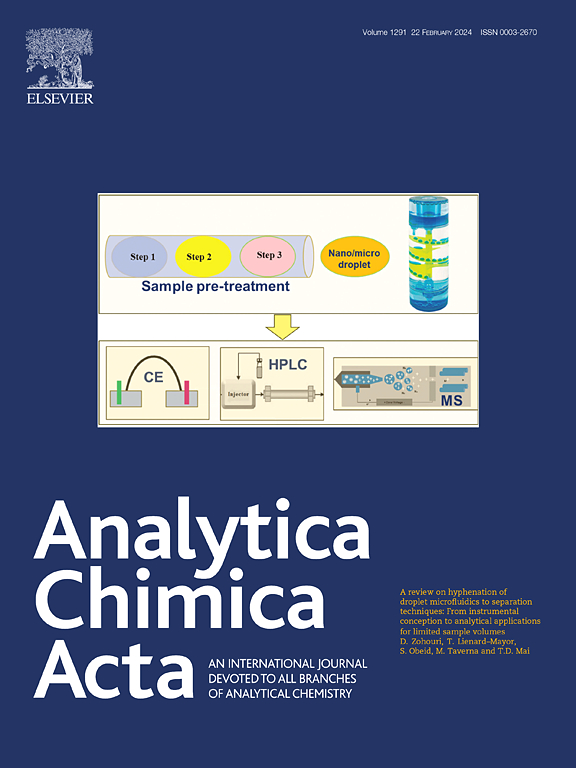Ultrasensitive SERS detection of cytokines through specific binding and multiple reporter molecules
IF 6
2区 化学
Q1 CHEMISTRY, ANALYTICAL
引用次数: 0
Abstract
Interleukins (IL) play a vital part in molecular recognition as well as immune response, and their excessive or inappropriate production can lead to inflammatory and cardiovascular diseases, etc., which are harmful to human physical and mental health. Thus, there is a pressing need to develop a strategy for the rapid and highly sensitive detection of such low concentration substances. In this study, we developed a Surface enhanced Raman spectroscopy (SERS) immunosensor for qualitative and quantitative analysis of multiple cytokines (IL-1, IL-4 and IL-6). Three Raman reporters were modified on gold nanoparticles and coupled with corresponding antibodies to form immunoprobes. The silver nanospace folded rods were prepared by tilted angle deposition technique, connected with antibodies to form an immunosensor. When the target antigen appeared on the immunosensor, it would specifically bind with the antibody to form a “sandwich” structure. Respectively, the detection limits of IL-6, IL-1 and IL-4 were 1.00 pg/mL, 0.93 pg/mL and 1.00 pg/mL. The three inflammatory factors were successfully distinguished and predicted by machine learning. In addition, we detected and calculated the recovery of IL-6 cytokines in saliva samples. The method can achieve quantitative detection and qualitative differentiation of target detectors in a wide concentration range. Meanwhile, it has the advantages of rapidity, simplicity and high specificity, which has a broad application prospect in biomedical field.


通过特异性结合和多个报告分子对细胞因子进行超灵敏的SERS检测
白细胞介素(interleukin, IL)在分子识别和免疫应答中起着至关重要的作用,其过量或不适当的产生可导致炎症和心血管疾病等,对人体身心健康有害。因此,迫切需要制定一种快速和高灵敏度检测这种低浓度物质的策略。在这项研究中,我们开发了一种表面增强拉曼光谱(SERS)免疫传感器,用于多种细胞因子(IL-1, IL-4和IL-6)的定性和定量分析。将三个拉曼报告蛋白修饰在金纳米颗粒上,并与相应的抗体偶联形成免疫探针。采用倾斜角沉积技术制备银纳米空间折叠棒,并与抗体连接形成免疫传感器。当目标抗原出现在免疫传感器上时,它会特异性地与抗体结合,形成“三明治”结构。IL-6、IL-1和IL-4的检出限分别为1.00 pg/mL、0.93 pg/mL和1.00 pg/mL。通过机器学习成功区分和预测了这三种炎症因子。此外,我们检测并计算了唾液样本中IL-6细胞因子的回收率。该方法可在较宽的浓度范围内实现目标检测器的定量检测和定性鉴别。同时具有快速、简便、特异性高等优点,在生物医学领域具有广阔的应用前景。
本文章由计算机程序翻译,如有差异,请以英文原文为准。
求助全文
约1分钟内获得全文
求助全文
来源期刊

Analytica Chimica Acta
化学-分析化学
CiteScore
10.40
自引率
6.50%
发文量
1081
审稿时长
38 days
期刊介绍:
Analytica Chimica Acta has an open access mirror journal Analytica Chimica Acta: X, sharing the same aims and scope, editorial team, submission system and rigorous peer review.
Analytica Chimica Acta provides a forum for the rapid publication of original research, and critical, comprehensive reviews dealing with all aspects of fundamental and applied modern analytical chemistry. The journal welcomes the submission of research papers which report studies concerning the development of new and significant analytical methodologies. In determining the suitability of submitted articles for publication, particular scrutiny will be placed on the degree of novelty and impact of the research and the extent to which it adds to the existing body of knowledge in analytical chemistry.
 求助内容:
求助内容: 应助结果提醒方式:
应助结果提醒方式:


